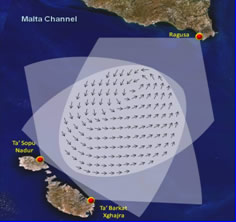
In Greek mythology, Calypso was the daughter of the titan Atlas (also known as Oceanus) and was a nymph living on the magical island of Ogygna. As referred to by Homer in ‘The Odyssey’, she seduced and imprisoned Odysseus on his journey home from the Trojan War, and promised him immortality if he would sojourn permanently with her in the cave. Some people are convinced that Ogygna is indeed the island of Gozo, within the Maltese archipelago, which consequently is also known as Calypso. Over Ramla bay, the most prominent sandy beach in the Maltese Islands, one finds Calypso’s cave, a complex labyrinth which was reputed to extend to sea level in places.
Times have changed, but perils still threaten the Mediterranean basin, although their nature is somewhat different from when Homer penned his masterpiece. The risk of oil from marine spillages beaching on shores, hitting important economic resources and causing irreversible environmental damage is a very realistic menace in the stretch of sea between Malta and Sicily. Especially in a small island state like Malta where economic assets are concentrated in space, the damage would be even more devastating. Risk is high because the islands are situated along the main shipping lanes of the Mediterranean Sea.
Risks can be highly minimised by using the best tools for surveillance, operational monitoring against pollution threats, as well as a capacity to respond with informed decisions in case of emergency. CALYPSO is a research project that intends to utilise a top-end technology, consisting of an array of High Frequency (HF) radars, to monitor in real-time meteo-marine surface conditions. Like the nymph Calypso, the HF Radars will vigilate on the stretch of sea extending from Malta to the Sicilian shores.

The project is partly financed by the EU European Regional Development Fund under the Operational Programme Italia-Malta 2007-2013, and co-ordinated by Prof. Aldo Drago from the Physical Oceanography Unit of the University of Malta. It brings together 3 other partners from Malta – namely Transport Malta, Civil Protection Department and Armed Forces of Malta – and 4 partners from Sicily – ARPA Sicilia, IAMC-CNR Capo Granitola, Universita’ degli Studi di Palermo (UNIPA) and Universita’ di Catania (CUTGANA). The consortium consists of research entities and also public entities with responsibilities for civil and environmental protection, surveillance, security and response to hazards.
The project will set up a permanent and fully operational HF radar observing system, capable of recording (in real-time with hourly updates) surface currents in the Malta Channel. The system consists of HF radar installations on the northern Malta and southern Sicilian shores. The radars are expected to be installed in summer this year, and the whole system will be operational by end of 2012.
More information on http://www.capemalta.net/calypso/
